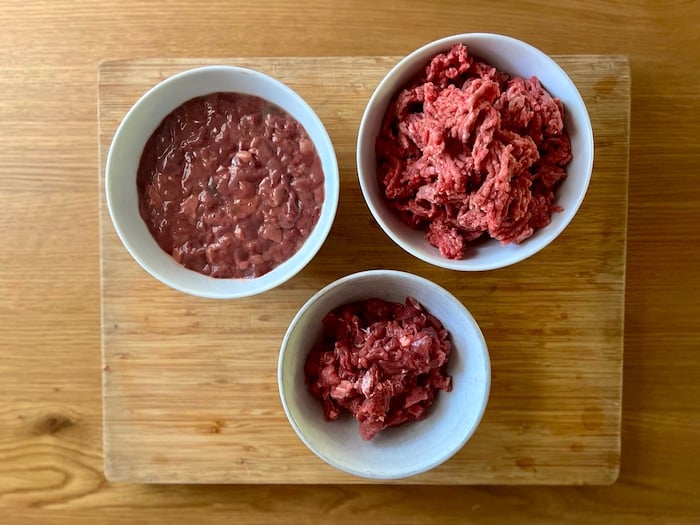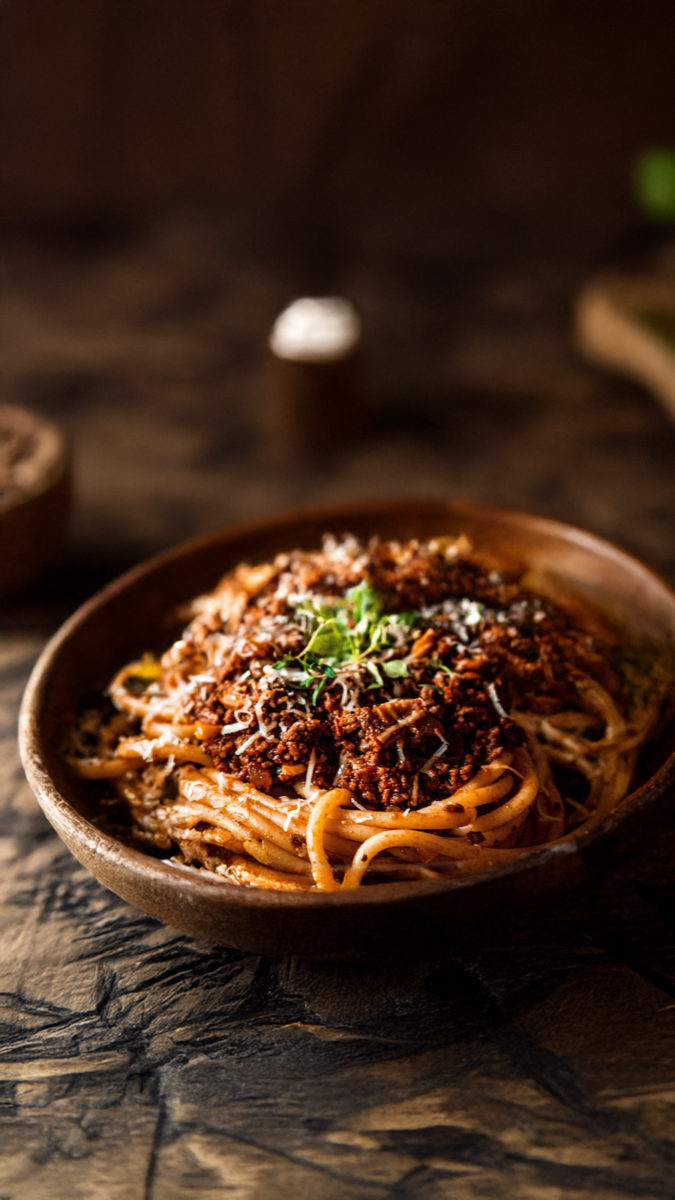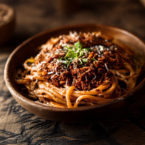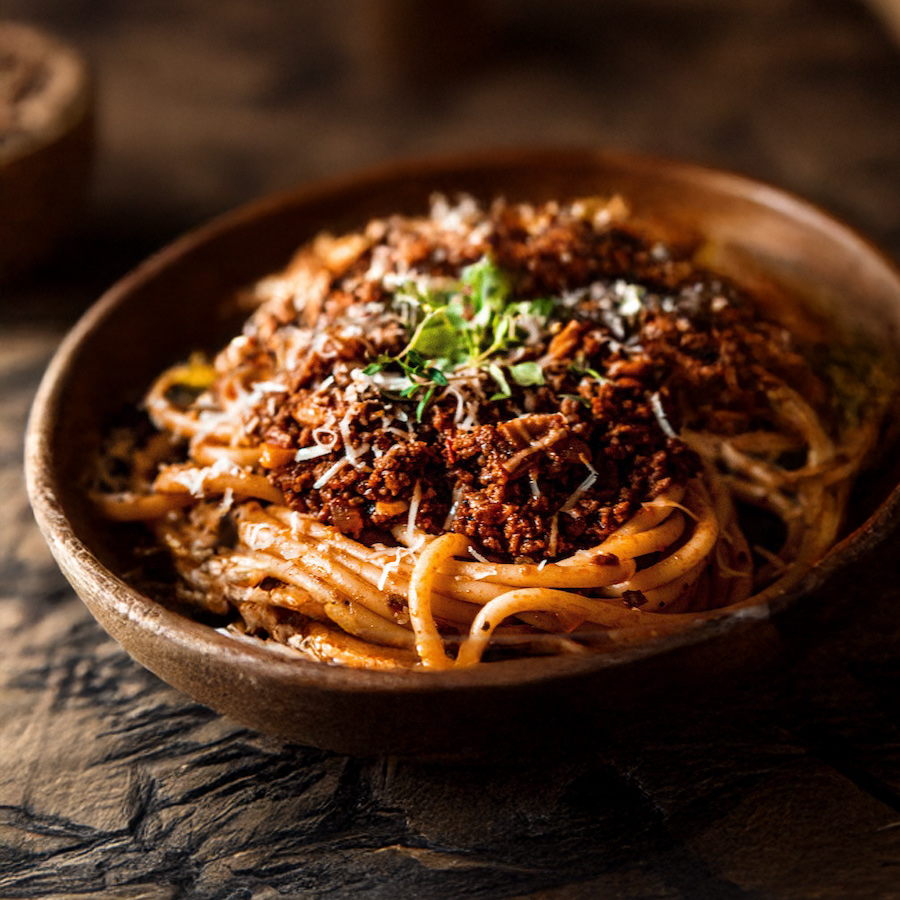There are few dishes as satisfying as ragù Bolognese. The classic Italian meat sauce, so often mistreated, but when done right – elegant, comforting and delicious all at once.
The original recipe, stemming back to the 18th century, included veal fillet, pancetta and finely minced vegetables. It didn’t have tomatoes, and it was certainly not the strangely sweet – marinara sauce creation that is so prevalent at many subpar Italian restaurants across the globe.
For me, a ragù isn’t really about vegetables or tomatoes, but very much about meat. Or should I say meats? Because in this version, we’re covering all bases. Pork, chicken, beef and lamb. Why? To create a stew with multiple flavors and textures that all come together through the magic of time and heat, and is turned into an elegant layered symphony of rich goodness. So what are the keys to what I think is the perfect ragù? Let’s take a look!

The Meat(s)
Pork
The classic recipe calls for Pancetta, and that’s by far my preference from the pig-aisle when it comes to any ragú. The pancetta provides a cured saltiness, and finely chopped it almost disappears after a few hours of simmering. But the flavors linger, infusing your ragù with Italian-umami deliciousness.
Chicken
Here, I’m going for chicken liver. One of the most inexpensive types of meat you can get, and at the same time one of the most flavorful. It doesn’t hurt that it’s a great source of protein and low calorie. I know many of you have a hard time with the taste of liver, but don’t worry – here, it just adds a wonderful earthiness to the stew, and we chop it so finely that you’ll almost feel them melting in your mouth as you eat.
Lamb
Time to get some oomph into our ragù. I used lamb shoulder for this particular version, but any cut of lamb works. Finely chopped and browned it lends a wildness to the stew that I think elevates the whole experience into something quite unique.
Beef
I’m going for the easy solution here. Ground beef with high fat content provides the meaty base of the stew. No need to get overly fancy, but if you want to be extra rustic with your ragù you may want to hand cut a piece of chuck into small cubes instead of using ground beef. Your choice how many chef points you want to collect!
The Other Stuff
Vegetables
Ok, so I do often use some celery and carrots in my ragù, but this is pretty much the “all meat” version. I don’t want anything to take away from the deep, umami-rich flavors of the meats – so I’m leaving everything else than garlic, herbs and tomatoes out of it.
Tomatoes
Just one rule here. Don’t overdo it. This is not a tomato sauce with some meat in it – but a meat sauce with a little tomato in it. Use as expensive a canned tomato as you can (since canned tomatoes are cheap, you won’t break the bank by choosing the top brands – Bianco DiNapoli Organic Whole Peeled Tomatoes are my favorite), and then combine with a couple of fresh, sweet tomatoes. I make sure to blend the tomatoes together before adding them to the sauce, because I don’t want any bits and pieces of tomato floating around in my end result.
Wine
I know there are different takes on what wine to use for ragù, and I’m not against red or white. But for this one, I used a dry Sauvignon Blanc – and my only advice would be to stay away from anything too sweet. A red wine makes the stew a little darker and richer, but that’s not necessarily a bad thing – just a matter of taste, really.
Cream
Yes, the official recipe, registered with the Bologna chamber of commerce, states that a Bolognese sauce should contain milk. Why? Because if makes for more tender meat and a smoother blending of the flavors. For me though, I like to kick it up a notch with a couple of splashes of heavy cream. This provides a richness that takes the ragù from pedestrian to royal – just the way you deserve!
Ok, I think we’re ready to start cooking! On to the recipe.

How to Make Ragú Bolognese at Home
1. Prepare the Meats:
- Finely dice the lamb and chicken liver into small cubes (about 1/5 inch).
- Slice the pancetta thinly.
- In a deep skillet, melt the butter over medium-high heat and cook the meats individually until browned on all sides. Set each aside once browned, and save any residual cooking liquid.
2. Build the Base:
- Return all the browned meats to the skillet. Add the smashed garlic cloves, bay leaves, parsley, oregano, and basil.
- Stir for about a minute over high heat to let the flavors meld.
3. Add the Wine:
- Pour the white wine into the skillet and allow it to boil vigorously for 5-7 minutes, reducing the alcohol content.
4. Simmer with Stock:
- Lower the heat to medium. Add the beef bouillon (or stock) and bring the mixture to a simmer.
- Blend the canned tomatoes and fresh tomatoes in a blender until smooth. Add about 2/3 of this tomato sauce to the ragu mixture.
5. Slow Cooking:
- Reduce heat to low, cover the skillet, and let the ragu simmer for 2.5 hours, checking every 30 minutes. Add water if necessary to keep the meat submerged.
- After 1.5 hours, taste and adjust the tomato sauce to your preference. You may add more if desired.
6. Finish the Sauce:
- After 2.5 hours, stir in half of the grated parmesan and let the ragu simmer for another 5 minutes.
- Add the heavy cream and continue simmering uncovered for 20-25 minutes to thicken.
7. Serve:
- Toss the finished ragu with your favorite al dente pasta. Garnish with the remaining parmesan and serve hot.
Recipe Notes:
- Cooking the Meats: Cooking each meat separately ensures that each one is browned and develops its unique flavor.
- Tomato Adjustments: You can adjust the amount of tomato sauce based on your personal preference for tomato flavor.
- Simmering: The slow simmering process deepens the flavors, so make sure to let the ragu cook for the full 2.5 hours.
- Cream: Adding the heavy cream at the end makes the sauce rich and velvety, balancing the acidity of the tomatoes.

The Four Meats Ragù Bolognese
- Total Time: 3 hours 30 minutes
- Yield: Serves 4-6 1x
Description
A version of the classic ragù Bolognese with four different meats that create a luxurious and elegant stew filled with umami-flavors.
Ingredients
1 lb ground beef (450g)
1 lb lamb, finely diced (450g)
1/2 lb chicken liver, finely diced (225g)
1/2 lb pancetta, finely sliced (225g)
6 cloves garlic, smashed
1 can (28 oz/800g) organic peeled tomatoes
3 medium-sized fresh sweet tomatoes
2 tbsp Better than Bouillon beef stock (or 1 quart/950ml good beef stock)
2 tbsp parsley flakes
2 tbsp dried oregano
2 tbsp dried basil
4 bay leaves
1/2 cup extra virgin olive oil (120ml)
Salt and pepper, to taste
Chili flakes, to taste
1 cup grated parmesan cheese (100g)
1/2 cup heavy cream (120ml)
1 bottle dry white wine (750ml)
1 tbsp butter (14g)
Instructions
1. Prepare the Meats:
- Finely dice the lamb and chicken liver into small cubes (about 1/5 inch).
- Slice the pancetta thinly.
- In a deep skillet, melt the butter over medium-high heat and cook the meats individually until browned on all sides. Set each aside once browned, and save any residual cooking liquid.
2. Build the Base:
- Return all the browned meats to the skillet. Add the smashed garlic cloves, bay leaves, parsley, oregano, and basil.
- Stir for about a minute over high heat to let the flavors meld.
3. Add the Wine:
- Pour the white wine into the skillet and allow it to boil vigorously for 5-7 minutes, reducing the alcohol content.
4. Simmer with Stock:
- Lower the heat to medium. Add the beef bouillon (or stock) and bring the mixture to a simmer.
- Blend the canned tomatoes and fresh tomatoes in a blender until smooth. Add about 2/3 of this tomato sauce to the ragu mixture.
5. Slow Cooking:
- Reduce heat to low, cover the skillet, and let the ragu simmer for 2.5 hours, checking every 30 minutes. Add water if necessary to keep the meat submerged.
- After 1.5 hours, taste and adjust the tomato sauce to your preference. You may add more if desired.
6. Finish the Sauce:
- After 2.5 hours, stir in half of the grated parmesan and let the ragu simmer for another 5 minutes.
- Add the heavy cream and continue simmering uncovered for 20-25 minutes to thicken.
7. Serve:
- Toss the finished ragu with your favorite al dente pasta. Garnish with the remaining parmesan and serve hot.
Notes
Cooking the Meats: Cooking each meat separately ensures that each one is browned and develops its unique flavor.
Tomato Adjustments: You can adjust the amount of tomato sauce based on your personal preference for tomato flavor.
Simmering: The slow simmering process deepens the flavors, so make sure to let the ragu cook for the full 2.5 hours.
Cream: Adding the heavy cream at the end makes the sauce rich and velvety, balancing the acidity of the tomatoes.
- Prep Time: 30 minutes
- Cook Time: 3 hours
- Category: Italian Pasta Dish, Main Course, Pasta
- Method: Stove Top
- Cuisine: Italian, Italian-Inspired
Nutrition
- Serving Size: 1 cup
- Calories: 510
- Sugar: 5g
- Sodium: 620mg
- Fat: 35g
- Saturated Fat: 14g
- Unsaturated Fat: 17g
- Trans Fat: 0g
- Carbohydrates: 14g
- Fiber: 2g
- Protein: 28g
- Cholesterol: 115mg






















Super easy to make and absolutely delicious. A new go-to recipe in my house! Love it!
OMG this is by far the best ragu recipe I have ever tried. The chicken liver is what does it!!
This was by far the best ragu I have ever tasted. I am saving this FOREVER!!!
Oh my god, this was absolutely delicious. I don’t normally like chicken liver, but I could just taste a slight earthiness. So frickin good!
What size canned peeled tomatoes?
Hey Mitch, for this recipe, if you do the full three pounds of meat – I recommend a 28oz can.